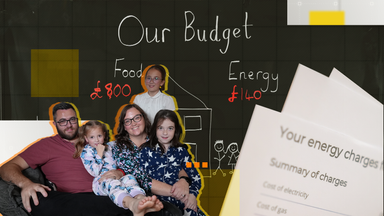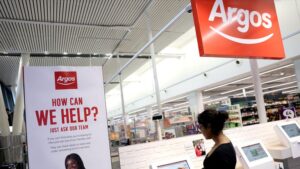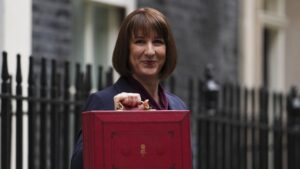How the budget could make things worse for millions of working people with extreme money troubles
Exclusive analysis by Sky News reveals that many people on low and middle incomes are being pushed towards poverty. And it suggests some of the government’s anticipated tax and benefits changes could hit some lower-paid workers the hardest.

Lowri Williams is struggling to cover her basic expenses. Earning a low income with very little support, she says she feels like she’s “living hand-to-mouth” and barely getting by.
She’s one of a large group of people in low-income households who are caught in a precarious position, earning too little to comfortably support themselves, but too much to qualify for significant financial help.
For people like Lowri, working more or earning a higher income could mean losing vital support like Universal Credit, leaving them no better off and in some cases even worse off.
Higher tax bills for the lowest paid
Lowri’s salary is not high enough to pay tax. But there’s a wider group of low-income earners who are facing a heavy tax burden.
Sky News analysis has found that in the last three years, working people in the bottom 25% of earners have effectively had a 60% tax hike.
This is due to the freeze on personal allowances, introduced in 2021 and scheduled to end in 2028. For each year the freeze is enacted, earners effectively see their tax rates rise in real terms as a higher proportion of their income becomes taxable.
Labour may extend the freeze in their budget this week. If the chancellor proceeds with the plan, around 400,000 people who are currently exempt will find themselves paying income tax, and many current taxpayers will pay higher rates.
On top of this, low to middle-income households are seeing significant stagnation in how much their income is going up, according to analysis of Department for Work and Pensions (DWP) data by the Resolution Foundation.
This finding is part of an upcoming report in November, obtained by Sky News, which will delve deeper into the financial pressures these households face.
Between the mid-1990s and early 2000s, low to middle-income households experienced an almost 50% rise in income. But in the last decade, that growth has slowed dramatically to just 11%.
Fluctuating earnings and a squeeze on benefits
The government is also reportedly considering restricting sickness benefits, a move which may exacerbate the issue.
“Economic vulnerability and insecurity are particularly high among people with ill health or disabilities,” said Alfie Stirling, director of insight and policy at the Joseph Rowntree Foundation.
“Any policy that reduces their support, or limits access to it, will likely worsen hardship and increase the number of people at risk,” he added.
Low income families in these situations can receive state support like Universal Credit to supplement their income.
Universal Credit, first introduced in 2013, combines several state-funded benefits, including housing support, child tax credits, and income support, into one payment. It provides support to households both in and out of work.
Around 2.5 million people in work receive this support, but some, like Lowri, a part-time charity worker, miss out at times due to fluctuating monthly earnings.
Universal Credit is reduced by 55p for every £1 earned, a calculation known as the taper rate. Some people receive an allowance before this reduction, depending on their circumstances.
Lowri, who is impacted by the taper rate, explained: “If you earn over the limit, you lose out immediately. Not only do you lose Universal Credit, but also your council tax benefit, which is another £150 a month.
“So, while you might earn £50 more, you could end up £100 worse off.”
“Every penny you have coming in is paying just bills,” she said.
Finding ways to save
Below is Lowri’s household expenditure for some essential bills.
While she’s able to receive UC, she’s eligible for social tariffs, which are a discounted package for household bills, which could help her save.
This could amount to a saving of nearly £70 for Lowri’s mobile and broadband budget, according to analysis by Nous, an AI-powered household bill manager.
With social tariffs in place, her water bill could be cut in half.
The National Living Wage
While Lowri’s income means she doesn’t pay tax, people on the National Living Wage (NLW), £11.44 per hour (£22,308 annually), who earn more than her, are heavily affected by tax and benefits decisions made by the Conservative government, which Labour are reportedly proposing to extend.
At the budget in March, the NLW increased by 10%.
The chancellor may announce a further hike in the NLW at this week’s budget, which sounds like good news.
But Lalitha Try, economist at the Resolution Foundation says: “Our research shows that the introduction and ramping up of the minimum wage has delivered a major living standards boost to lower income families over the past 25 years.
“But it’s important to recognise that there are limits to what it can achieve. For workers on Universal Credit, over half of the wage gains will be clawed back through lower benefit entitlement.
And the minimum wage can’t help those who may earn more than the legal minimum but struggle with low hours or high housing costs. Other policies are needed to solve those challenges.”
Losing access to support like Universal Credit could also mean people no longer qualify for things like social tariffs and free school meals.
On top of that, the freezing of the personal allowance thresholds which heavily affects the lowest 25% of earners in the UK has also had a significant impact on people earning the NLW.
The amount of tax that someone working full time on the living wage will pay annually in 2024/2025 is over £1,000 more in real terms than it was in 2019/2020.
That’s a lot of money for someone earning just over £22,000 per year.
It means their effective tax rate has almost doubled, from 4.4% to 8.7%, in five years.
These are only a few examples of how an increase in NLW means they have less money in their pockets.

Keep up with all the latest news from the UK and around the world by following Sky News
Two salaries and still struggling
It’s a similar story for people on what is meant to be a more comfortable income.
Chris and Tracey Matthewman, who live with their three daughters in Basildon, Essex, are among the tens of millions of people living below the Minimum Income Standard (MIS).
This is the amount the Joseph Rowntree Foundation defines as necessary for an acceptable standard of living.
It goes beyond just food, clothing, and shelter; it includes the ability to participate in society, such as being able to socialise and having access to technology.
In 2024, the MIS was £28,000 for a single person and £69,400 for a couple with two children.
Tracey teaches in a primary school and Chris looks after the fleet of vehicles his company uses.
The Matthewman household income is below the Minimum Income Standard (MIS) for a family of their size, a little over £80,000 in total.
After tax, their combined household income is around £4,000 a month. A lot of that gets spent on energy bills and council tax, not to mention other essentials.
Chris is clearly worried about how to keep the family afloat. When I visited his home he repeatedly showed me his detailed spreadsheet which he uses to meticulously track his family’s expenses.
Chris says: “It’s frustrating. We have to accept living paycheque to paycheque, just surviving month to month.”
And Tracey had this message for Rachel Reeves, the chancellor, ahead of Labour’s budget: “They need to remember that there are people living in this country who don’t receive any benefits and are still struggling.”
“We’re in that demographic that ends up paying more – more national insurance, more tax. We keep tightening up, but we’re not eligible for any benefits. That’s tough.”
Additional reporting: Daniel Dunford, Senior Data Journalist
The Data and Forensics team is a multi-skilled unit dedicated to providing transparent journalism from Sky News. We gather, analyse and visualise data to tell data-driven stories. We combine traditional reporting skills with advanced analysis of satellite images, social media and other open source information. Through multimedia storytelling, we aim to better explain the world while also showing how our journalism is done.


